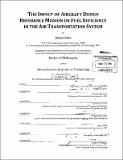The impact of aircraft design reference mission on fuel efficiency in the air transportation system
Author(s)
Yutko, Brian M. (Brian Matthew)
DownloadFull printable version (28.42Mb)
Other Contributors
Massachusetts Institute of Technology. Department of Aeronautics and Astronautics.
Advisor
R. John Hansman.
Terms of use
Metadata
Show full item recordAbstract
Existing commercial aircraft are designed for high mission flexibility, which results in decreased fuel efficiency throughout the operational life of an aircraft. The objective of this research is to quantify the impact of this practice and other non-optimal emergent behaviors of the current global air transportation system. The analysis focuses on improvements that can be made using existing technology. Previous attempts at performing this type of analysis, especially the joint optimization of aircraft design and operations, have been hindered by problem complexity and computational time. In order to overcome these issues and perform the analysis on a global scale, a machine-learning algorithm is used to create a computationally efficient artificial neural network relating aircraft design and off-design mission performance to operational fuel burn and flight time. The data used to train the aircraft performance neural network is generated from an extensive sample of new vehicles optimized for minimum fuel burn on an extremely broad combination of Design Reference Missions (design-payload, -range, and cruise Mach). The resulting comprehensive model of aircraft performance is capable of solving large-scale air transportation network optimization problems. A set of scenarios is analyzed to both establish the limits of the major contributors to system fuel consumption and determine potential realistic benefits from introducing new aircraft with varying design reference missions. Results indicate that approximately 33% of current system fuel consumption is due to the slow retirement and replacement of aircraft in the operational fleet. Additionally, a significant pool of potential fuel burn savings can be realized by designing aircraft closer to their intended operating regime. Multiple large-scale optimization scenarios are presented, including the optimal choice of new aircraft designs for fixed cruise Mach numbers and the globally optimum aircraft choices given any cruise Mach. It is found that reducing design cruise speed can yield system fuel benefits on the order of 7%. Fuel stops are shown as a potentially promising method to operate long-haul missions closer to the maximum fuel efficiency range of an aircraft, and also as a way to mitigate the impact of designing high-efficiency, short-range aircraft that can no longer fly long haul missions directly.
Description
Thesis: Ph. D., Massachusetts Institute of Technology, Department of Aeronautics and Astronautics, February 2014. Cataloged from PDF version of thesis. "October 2013." Includes bibliographical references (pages 153-157).
Date issued
2014Department
Massachusetts Institute of Technology. Department of Aeronautics and AstronauticsPublisher
Massachusetts Institute of Technology
Keywords
Aeronautics and Astronautics.